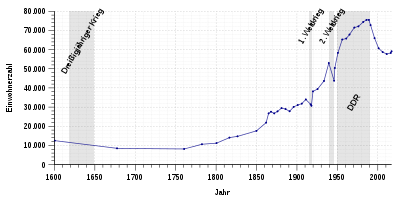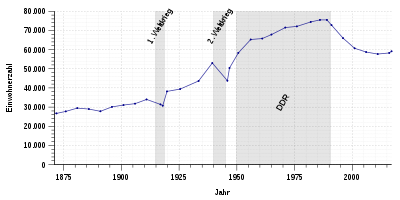Stralsund
![]()
The title of this article is ambiguous. For other meanings, see Stralsund (disambiguation).
Stralsund [ˈʃtʁaːlzʊnt] (since 1990 with official name: Hansestadt Stralsund) is a city in northeastern Germany. It is part of the Vorpommern district of the German state of Mecklenburg-Vorpommern and is the county seat in the Vorpommern-Rügen district. According to state law, Stralsund has the designation Hanseatic city and large district city.
Stralsund received the Lübische Stadtrecht in 1234. This makes it the oldest city in Pomerania. As a founding member of the Hanseatic League, the city achieved considerable prosperity through international trade. The old town with its numerous architectural monuments and particularly valuable testimonies of brick Gothic has been a UNESCO World Heritage Site since 2002 with the title Old Towns of Stralsund and Wismar. Stralsund, as a resort and important tourist centre of the southern Baltic Sea region, is also known for the German Oceanographic Museum with the Stralsund Oceanographic Museum, the Stralsund Museum and for events such as the annual Wallenstein Days and the Rügen Bridge Marathon. Economically, tourism dominates. Other economic sectors are public administration, shipbuilding and mechanical engineering, service companies, logistics, the health industry and companies in the field of information technology and biomedical technology. Since 1991, the medium-sized town has been the seat of the Stralsund University of Applied Sciences, and the neighbouring town of Parow has been home to the German Naval Technology School since 1996.
Stralsund is called the "Gateway to the Island of Rügen" because of its location on the Strelasund, a strait in the Baltic Sea between the mainland and the island of Rügen.

The town hall at the Old Market
,_by_Klugschnacker_in_Wikipedia_(9).JPG)
Stralsund seen from Altefähr (2013)
_4.JPG)
Aerial view with old town island at the Strelasund (2011).
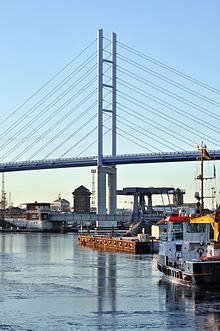
Rügen bridge from Stralsund to Rügen (view from Dänholm)
Geography
Regional planning
Together with Greifswald, Stralsund forms one of the four regional centres of Mecklenburg-Vorpommern. In the regional development programmes for the state and in the Vorpommern planning association, close cooperation is envisaged between Stralsund and its surrounding area and Greifswald. Both Hanseatic cities had a combined population of around 118,000, while the intervening administrative districts of Miltzow and Landhagen and Grimmen had a combined population of around 27,000 (2018). The nearest conurbations relevant for
the city region are the Rostock regiopolis and the metropolitan regions of Szczecin in the east, Berlin in the southeast, Hamburg in the west and Copenhagen-Malmö in the north.
City breakdown
After the abolition of the fortress character of the old town in 1869, the surrounding areas were settled.
The area of Stralsund is divided into the following urban areas and districts:
| No. | City area | District | Inhabitants |
| 01 | Old Town | 6.090 | |
| 011 | Old Town | Old Town | 5.775 |
| 012 | Old Town | Harbour Island | 26 |
| 013 | Old Town | Bastion Belt | 289 |
| 02 | Knieper | 25.270 | |
| 021 | Knieper | Kniepervorstadt | 6.179 |
| 022 | Knieper | Kneeper North | 6.677 |
| 023 | Knieper | Kneeper West | 12.414 |
| 03 | Tribseer | 10.268 | |
| 031 | Tribseer | Tribseer suburb | 5.366 |
| 032 | Tribseer | Tribsee estate | 3.484 |
| 033 | Tribseer | Tribsee meadows | 1.292 |
| 034 | Tribseer | Schramm's mill | 126 |
| 04 | Franconia | 6.732 | |
| 041 | Franconia | Frankenvorstadt | 5.335 |
| 042 | Franconia | Dänholm | 187 |
| 043 | Franconia | Franconia center | 417 |
| 044 | Franconia | Frankensiedlung | 793 |
| 05 | South | 4.166 | |
| 051 | South | Andershof | 3.521 |
| 052 | South | Devin | 571 |
| 053 | South | Voigdehagen | 74 |
| 06 | Lüssow mountain | 220 | |
| 07 | Langendorf Mountain | 299 | |
| 08 | Greenhufe | 6.565 | |
| 081 | Greenhufe | City Paddock | 321 |
| 082 | Greenhufe | Vogelsang | 2.541 |
| 083 | Greenhufe | Green Valley Fourth of July | 3.630 |
| 084 | Greenhufe | Freienlande | 73 |
The foundation stone for the Knieper West I residential area was laid on 26 August 1964. It followed the Knieper Nord district as the second prefabricated housing area in the city. In January 1976, construction began on the first apartment block in the Knieper West III residential area. The last residential block there for the time being was built in 1981; it was followed in 1989 by two "cube houses" for housing suitable for the elderly.
The town also owns estates in the surrounding area and on the islands of Rügen, Hiddensee and Ummanz.
Neighboring communities
Many of the formerly smaller villages in the area, such as Parow, Prohn, Wendorf (OT Neu Lüdershagen) or Negast, have grown strongly since 1990 due to the influx of people from Stralsund or those working in Stralsund.
The towns of Barth, Grimmen and Ribnitz-Damgarten are also in the immediate vicinity of Stralsund, while the city of Greifswald is a good 30 km south-east of Stralsund.
Climate
The annual precipitation is 656 mm and is thus comparatively low; it falls into the lower third of the values recorded in Germany. The driest month is February, the most precipitation falls in July: in this month 2.1 times more precipitation falls than in February. Precipitation varies moderately.
Landscapes, elevations, waters
The city is located on the Strelasund, a strait of the Baltic Sea. The geographical proximity to the island of Rügen earned Stralsund the name Gateway to the Island of Rügen. There is both a causeway and bridge connecting the city and the island - the Rügendamm across the island of Dänholm to Altefähr - and a bridge, the Rügenbrücke; both connections form the only fixed Strelasund crossings. Stralsund is close to the National Park Vorpommersche Boddenlandschaft with its great biodiversity.
Stralsund's urban area includes a city forest and three city ponds (Knieperteich, Frankenteich and Moorteich). The three ponds and the Strelasund gave the original settlement area and historical centre of the city, now called the Old Town, a protected island location.
The highest elevation in the city is the Galgenberg at the western entrance to the city; the hospital church of the Krankenhaus West has stood on this spot since 1912.
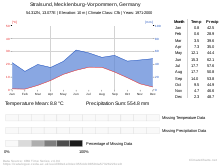
Climate diagram Stralsund
History
→ Main article: History of the Hanseatic City of Stralsund
Name
The settlement of Strale has been known since the 10th century. Stralesund as a town name was first mentioned in a document in 1240. The Strelasund is an inlet of the Baltic Sea.
Since 1990, the city has been preceded by the name Hansestadt (Hanseatic City) before its name Stralsund.
Middle Ages until 1900
After the settlement in the course of the German settlement in the East, Stralsund received the town charter according to the Rostock and Lübeck model from the Rügen prince Wizlaw I on 31 October 1234. The area had been settled by Slavs, which also explains its Slavic name component Stral (stral means arrow or spearhead, -sund in Germanic languages stands for a separating narrowness and here means the Strelasund).
Stralsund quickly became an important trading town in the Baltic region, mainly due to settlers from Westphalia. After the extinction of the principality of Rügen in 1325, the city belonged to Pomerania-Wolgast. In the 14th century it was the most important Hanseatic city in the southern Baltic region after Lübeck. Numerous armed conflicts with the rulers of Denmark culminated in the Peace of Stralsund in 1370. After the decline of the Hanseatic League, Stralsund's importance decreased. However, the city continued to live mainly from long-distance and local trade as well as shipbuilding.
As early as 1525, the majority of Stralsund's citizens converted to the Protestant faith. The city was thus the pacemaker of the Reformation in northern Germany.
During the Thirty Years' War Stralsund withstood the siege by Wallenstein's troops with the help of Sweden and Denmark; a period of almost 200 years of belonging to the Kingdom of Sweden as part of Swedish Pomerania followed. In 1815 Stralsund came to Prussia and became the seat of a government district with five counties.
1900 until today
After the First World War Stralsund briefly experienced violent unrest until a bourgeois municipal government was established in 1919; this was dissolved by the National Socialists in 1933. In 1939, 1,287 patients were deported from the Stralsund State Sanatorium. The deportees became victims of infanticide at various locations, including the Piaśnica massacre. On 1 May 1945 Stralsund was occupied by the Red Army; after the Second World War Stralsund was part of the Soviet occupied zone of Germany in 1945.
During the time of the German Democratic Republic (GDR), numerous prefabricated housing estates were built in the city, but the historic old town centre fell into disrepair. Economically, the city lived mainly from shipbuilding at the Volkswerft Stralsund, the ships for the Soviet Union were partly completed in 10-day intervals.
After the political turnaround, Stralsund became a model town for urban development funding in 1990. The historic city centre with the old town harbour was thoroughly redeveloped with the help of the programmes for urban development promotion and urban monument protection. The residential environment of the prefabricated housing estates Grünhufe and Knieper was also improved within the framework of the programmes "Upgrading", "Urban Redevelopment East" and "The Socially Integrative City", and a housing deconstruction was initiated.
Since 2002, Stralsund's old town, together with that of Wismar, has been a UNESCO World Heritage Site, under the name Historic Old Towns of Stralsund and Wismar. In the course of this, there has been a great surge of investment in monuments and infrastructure, which has boosted tourism.
Economically, there were major challenges after the reunification, which cause considerable problems in the structurally weak region. The resulting structural change is gradually leading to more stable population and labour market conditions. Thus, the population and employment figures in Stralsund have been rising continuously for some time.
In the course of the administrative district reform in 2011, the previously independent city of Stralsund and the administrative districts of Rügen and Nordvorpommern became part of the new administrative district of Vorpommern-Rügen with its administrative seat in Stralsund.
On 1 August 2016, Stralsund was awarded the designation of state-recognised resort. The districts Knieper West, Franken Mitte, Vogelsang and Grünthal-Viermorgen are excluded from this.
Street names and their meaning
The street names of Stralsund often reflect historical events.
Stralsund city fortifications
→ Main article: Stralsund city fortifications
Stralsund had the status of a fortress until 1871, which helped the city survive many wars. In addition to ten city gates, of which only the Kniepertor and the Kütertor have been preserved, the city ponds and dams were also built. The third town gate still preserved after the defortification, the Semlow Gate, damaged in the Second World War, was blown up in 1960.
Population development
In 1989, the population of the city of Stralsund peaked at over 75,000. Afterwards, the number of inhabitants dropped again due to the strong structural changes. After the political change in the GDR in 1989/1990, the city lost well over 15,000 inhabitants until 2008. For some years, however, a turnaround has been noticeable - the decline initially slowed down, and for 2012 there was a slight increase in the number of inhabitants again for the first time. Stralsund was also able to record this in the following years, so that the population now stands at 58,241.
The following overview shows the population figures according to the respective territorial status. Up to 1833, these are mostly estimates, thereafter census results or official updates by the respective statistical offices or the city administration itself. From 1843 onwards, the data refer to the "resident population", from 1925 onwards to the resident population and since 1966 to the "population at the place of the main residence".
|
|
|
Until the beginning of the 17th century Stralsund was the most populous city of the Duchy of Pomerania, larger than the capital Stettin.

City view after Merian (ca. 1640)
.JPG)
Bust of the Swedish King Gustav II Adolf in the Stralsund town hall
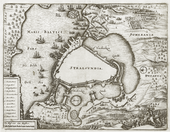
Stralsund: Siege during the Thirty Years' War

charter of 1234

Stralsund from the north in the Stralsund illuminated manuscript 1611/15
Questions and Answers
Q: Where is Stralsund located?
A: Stralsund is located in the state of Mecklenburg-Western Pomerania, Germany, on the south coast of the Strelasund.
Q: What is the Strelasund?
A: The Strelasund is a sound of the Baltic Sea that separates the island of Rügen from the mainland.
Q: When did Stralsund become a member of the Hanseatic League?
A: Stralsund became a member of the Hanseatic League in 1293.
Q: What was the German Democratic Republic?
A: The German Democratic Republic was the official name of East Germany, which existed from 1949 until German reunification in 1990.
Q: Was Stralsund part of the German Democratic Republic?
A: Yes, Stralsund was part of the German Democratic Republic from 1949 until German reunification in 1990.
Q: What is the significance of Stralsund's membership in the Hanseatic League?
A: The Hanseatic League was a powerful economic alliance of medieval cities, and Stralsund's membership in the league contributed to the town's economic and political importance.
Q: How was Stralsund affected by German reunification in 1990?
A: Stralsund became part of the reunified Germany in 1990, along with the rest of the former German Democratic Republic. This brought significant changes to the town's economy and society, as it became part of a larger, unified nation.
Search within the encyclopedia
